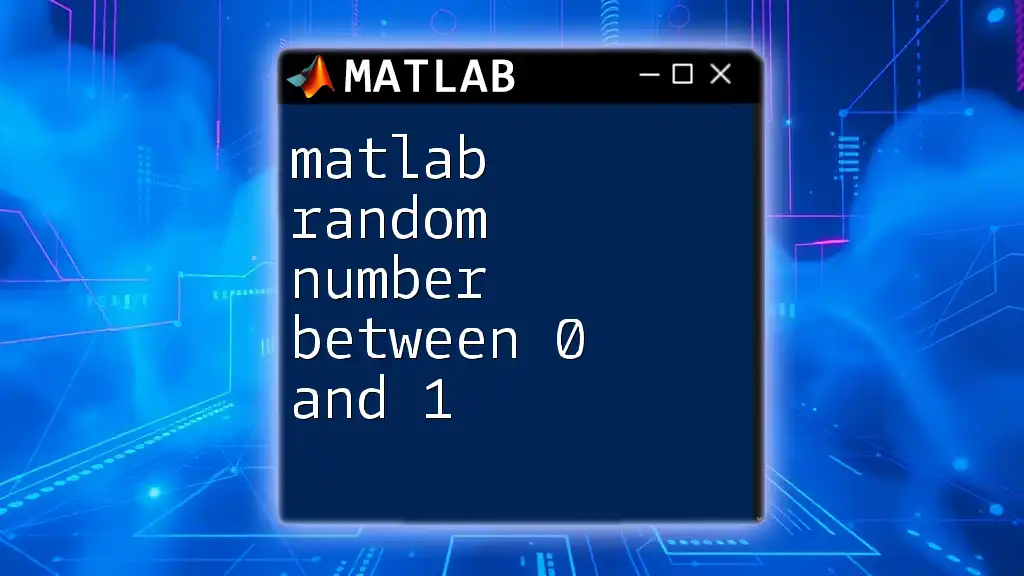In MATLAB, the magnitude of a complex number can be calculated using the built-in `abs` function, which returns the distance of the complex number from the origin in the complex plane.
z = 3 + 4i; % Example complex number
magnitude = abs(z); % Calculate magnitude
disp(magnitude); % Display the result
Understanding Complex Numbers
Definition of Complex Numbers
A complex number is defined as having both a real part and an imaginary part, expressed in the form \( z = a + bi \), where:
- \( a \) is the real part
- \( b \) is the imaginary part
- \( i \) is the imaginary unit, defined as \( i = \sqrt{-1} \)
Visual Representation of Complex Numbers
Complex numbers can be visualized on a complex plane, also known as an Argand diagram, where:
- The horizontal axis represents the real part.
- The vertical axis represents the imaginary part.
Each complex number corresponds to a point in this plane, where the distance from the origin represents its magnitude.

Importance of Magnitude
What Is Magnitude?
The magnitude of a complex number, often represented as \(|z|\), is essentially its distance from the origin in the complex plane. Mathematically, it is defined as:
\[ |z| = \sqrt{a^2 + b^2} \]
This formula emphasizes the relationship between the real and imaginary parts, allowing us to determine how far the complex number is from the origin.
Applications of Magnitude in Engineering and Science
Understanding the magnitude of complex numbers is vital in various fields, including:
- Signal Processing: Magnitude helps in analyzing signal strengths.
- Electrical Engineering: Used in calculations involving AC circuits.
- Control Systems: Magnitude is essential in determining system stability.

Using MATLAB to Calculate Magnitude of Complex Numbers
Built-in Functions
MATLAB provides a convenient built-in function, `abs(z)`, specifically designed to compute the magnitude of a complex number.
For example, consider the complex number \( z = 3 + 4i \):
z = 3 + 4i;
magnitude = abs(z);
In this code snippet, the variable `magnitude` will evaluate to \( 5 \), reflecting the distance from the origin, as \( |z| = \sqrt{3^2 + 4^2} = 5 \).
Manual Calculation of Magnitude
While the `abs` function is efficient, it's also instructive to calculate magnitude manually. By breaking the process down:
- Extract the real part using `real(z)`.
- Extract the imaginary part using `imag(z)`.
- Apply the formula for magnitude.
Here's how you can do it in MATLAB:
z = 3 + 4i;
a = real(z);
b = imag(z);
magnitude = sqrt(a^2 + b^2);
In this example:
- `real(z)` gives \( 3 \).
- `imag(z)` gives \( 4 \).
- The final calculation confirms that the magnitude is indeed \( 5 \).

Working with Arrays of Complex Numbers
Calculating Magnitude for Vectors
When dealing with arrays or vectors of complex numbers, MATLAB's `abs` function can handle entire arrays seamlessly. For instance, if you have several complex numbers:
Z = [2 + 3i, 4 + 5i, 1 - 1i];
magnitudes = abs(Z);
In this case, `magnitudes` will return an array containing the magnitudes of each complex number: \( [ \sqrt{13}, \sqrt{41}, \sqrt{2} ] \).
Using Element-wise Operations
For more customized operations on arrays, `arrayfun` allows you to apply a function to each element in the array. To find magnitudes using this approach, you can use:
Z = [2 + 3i, 4 + 5i, 1 - 1i];
magnitudes = arrayfun(@(z) abs(z), Z);
This will yield the same magnitudes as before, showcasing MATLAB's flexibility with vectorized operations.

Visualizing Complex Numbers and Magnitude
Plotting on the Complex Plane
Visual representation enhances understanding. You can plot complex numbers directly on the complex plane using the `plot` function:
Z = [2 + 3i, 4 + 5i, 1 - 1i];
plot(real(Z), imag(Z), 'o');
xlabel('Real Part');
ylabel('Imaginary Part');
grid on;
title('Complex Numbers on the Complex Plane');
This code will generate a scatter plot where each point represents a complex number, making it easier to visualize their positions in the complex plane.
Visualizing Magnitudes
To depict magnitudes visually, you can vary the size of the plotted markers in correlation to their magnitudes:
magnitudes = abs(Z);
scatter(real(Z), imag(Z), magnitudes * 10, 'filled');
Here, the size of each marker represents the magnitude, providing an intuitive understanding of how larger magnitudes correspond to greater distances from the origin.

Conclusion
The magnitude of a complex number in MATLAB can be efficiently calculated using built-in functions like `abs`, as well as through manual calculations that utilize the real and imaginary components. By mastering these techniques, you'll enhance your ability to work with complex numbers across various applications, whether in engineering, science, or mathematics.
To fully grasp this crucial concept, practice with examples and continue to explore MATLAB's extensive capabilities. As you delve deeper, the insights gained from manipulating complex numbers will undoubtedly prove invaluable across different domains.

















